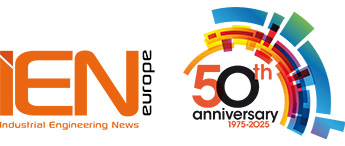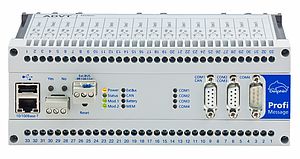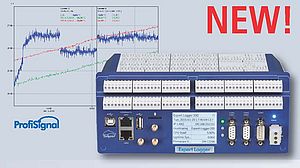Installation of new monitoring equipment often happens as part of a retrofit, in which older machines that were previously not monitored are equipped accordingly. However, new machines are also increasingly being delivered ex works with pre-installed measurement technology. Manufacturers can even expand their business model by offering their end customers not only the machine or system, but also the service "Condition Monitoring as a service".
But what is actually important here? Setting up a functioning condition monitoring system requires more than just sensors and measurement technology. On closer inspection, there are three levels that need to be considered - the data acquisition level, the central measurement data management level and the visualisation and control level.
Level 1 - The data acquisition level
The basis for functioning condition monitoring is reliable data acquisition on the machine or system. In addition to selecting the right sensors, it is very important to rely on a high-quality data acquisition system. First, it is essential to obtain precise and unadulterated measured values. This requirement can only be met by data acquisition devices with galvanically isolated analogue inputs, as these can reliably prevent parasitic influences such as earth loops. Care must also be taken to ensure that the appropriate inputs are available for the sensors to be connected and that the available sampling rate meets the requirements. Attention should also be paid to the available interfaces so that the measurement technology can be easily integrated into the existing infrastructure. In addition to a fail-safe data memory that prevents data loss even if the network connection is lost, it should also be possible to pre-process the measured values in the device, for example to perform an emergency shutdown of a machine if a certain measuring channel exceeds a limit value.
Delphin's measurement technology fulfils all of these requirements. The data acquisition devices have universally configurable, galvanically isolated analogue inputs and can be easily set up for any measurement task. In addition, Delphin offers a genuine vibration expert that can be used for any condition monitoring task where vibration monitoring plays a role. All devices have a fail-safe, industrial-quality internal data memory and, with the "software channels", offer automation options that go far beyond simply switching off a machine if a limit value is exceeded.
Level 2 - Centralised measurement data management
Precise measurement data acquisition is the basis of a reliable condition monitoring system. But what happens to the data, which is often distributed across different locations and initially not networked with each other? This requires a central instance that "collects", synchronises, stores and pre-processes the decentralised data and makes it available for joint visualisation and analysis.
With such centralised measurement data management software, high performance is particularly important in order to be able to process large volumes of data without delay. A wide range of interfaces is also important. It must not only be possible to use DAQ devices from a specific provider as data sources, but the software must be open for communication with any devices, regardless of whether they are data acquisition devices, PLCs, other field devices or intelligent sensors.
The Delphin Data Centre is a central measurement data management software that can process up to 100 million measured values per second thanks to a specially developed binary measurement database. This eliminates performance problems right from the start. The openness of the system is ensured by modern communication interfaces such as OPC UA and Modbus TCP. An API interface is also available for customised data exchange. This means that the recorded measurement data can also be transferred to external applications that have been programmed using Python, for example.
Level 3 - The visualisation level
What use is the most precise measurement data without good visualisation? Modern measurement technology software is required here that can display measurement data as independently as possible of the location and the end device used. Often, not only a diagram display of the measurement data is required, but also a complete system visualisation similar to a SCADA system.
Delphin has special platform-independent measurement technology software for this that can be used to display measurement data in suitable diagram types such as y(t), y(x), multi-track diagrams, bar charts and many more without any configuration effort. The special highlight here is that the software works on a smartphone or tablet as well as on a desktop PC. This makes it easy to access data from anywhere in the world. In addition many visualisation elements such as analogue and digital displays, LEDs as well as control elements such as buttons and rotary knobs are available. SCADA-like process diagrams can thus be realised without any programming effort.
An application example from construction machinery monitoring
Using a concrete application example, you will learn how modern condition monitoring on construction machinery has already been implemented with Delphin.
A construction machinery manufacturer wants to offer its end customers added value by providing them with up-to-date information on the maintenance status and process parameters of their construction machinery as an additional service.
When the end customer orders the service, a data acquisition device is installed in the relevant construction machine, which carries out vibration monitoring as well as monitoring other process parameters such as pressures and temperatures. The Expert Vibro vibration measuring device is used here, which enables the combined and synchronised recording of vibration measurement data up to 50 kHz and slower process data. The recorded measurement data is stored temporarily in the Expert Vibro and then transferred collectively to a central server of the construction machinery manufacturer, on which a Delphin Data Centre is installed to determine the maintenance status of the construction machine and give appropriate recommendations for action every end customer who booked the service for the the construction machinery they have purchased. The end customer can now use ProfiSignal 20 to access this information regardless of location and platform.
The customer benefit
The construction machinery manufacturer has expanded its business model to include "condition monitoring as a service" and can generate additional revenue. The construction machinery end customer can save a lot of time and money because he is always informed about the current condition of his construction machinery and can plan maintenance work much better.
With the complete solution from Delphin, all three areas are comprehensively covered and a reliable and future-proof condition monitoring system can be easily realised. With "condition monitoring as a service", machine and system manufacturers can offer their end customers significant added value and thus clearly set themselves apart from the competition.




















